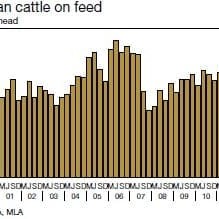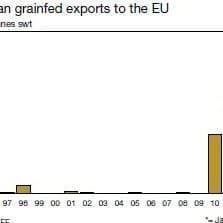Not since the dry years of the early 2000s has the feedlot sector played such an important role as it has in 2013 in mitigating the effects of drought across Eastern Australia.
The very dry conditions across large swathes of Eastern Australia since last summer, coupled with no autumn break in the south, forced cattle prices to their lowest level for several years, chief economist Tim McRae points out in Meat & Livestock Australia’s mid-year Industry Projections update released yesterday.
Exacerbating the situation was the extent of the poor pasture conditions, with many producers having few options to lease country, send cattle on agistment or push them on to the stock route.
As a result, cattle prices and quality declined significantly, which spurred additional lotfeeding activity – pushing the number of cattle on feed well above the levels anticipated in MLA’s January annual industry projections forecast.
The increased numbers on feed was more a factor of cattle prices declining and pastures conditions deteriorating, rather than increased demand, Mr McRae said. Feeder steer prices during June averaging 178¢/kg liveweight, down 13pc year-on-year.
 The number of cattle on feed during the March quarter increased 6pc year-on-year and 1pc on the December quarter, to 799,000 head, reaching the highest first quarterly numbers on feed since 2007.
The number of cattle on feed during the March quarter increased 6pc year-on-year and 1pc on the December quarter, to 799,000 head, reaching the highest first quarterly numbers on feed since 2007.
With the June quarterly survey figures likely to be released around mid-August, numbers on feed will have more than likely broken the 800,000 head barrier, as a result of the continued dry conditions, MLA suggests.
“While numbers on feed are expected to have increased considerably after cattle prices and seasonal conditions deteriorated, feed grain prices also crept higher, offsetting some of the gains anticipated for lotfeeders from the lower cattle prices,” Mr McRae said.
Wheat prices in the Darling Downs during June averaged, $325/t, while those in the Riverina averaged $281/t, up 41pc and 38pc respectively, year-on-year.
Looking ahead, according to ABARES estimates, the area of wheat sown this year in Australia is up 3pc, due to timely rainfall in the eastern states.
In addition, with a very positive three month outlook for most of Australia, winter crop production is forecast to increase 10pc year-on-year in 2013-14, meaning feed grain prices are likely to remain steady.
Driven by the increase in numbers on feed, Australian grainfed beef exports for the first six months of the year were up 9pc on the corresponding period last year, at 96,200t. Grainfed exports for the first six months made up 19pc of the total 500,000t of beef exported.
The mid-year Projections update said grainfed beef shipments to Japan had been impacted by the recent relaxation on the age restriction on US beef entering Japan. During June, shipments were back 16pc year-on-year, at 9600t, taking the total for the January- June period to 57,500t, back 4pc on the corresponding period in 2012.
While grassfed shipments to Korea have surged in 2013, grainfed exports have been steady, with the year-to-June total at 14,000t. In contrast, China continues to shine as a developing export destination, with grainfed shipments for the first six months up 1467pc on the five-year average, at 7300t.
Similarly, the EU is coming into focus as a major grainfed export destination; after Australia was granted access to the grainfed quota in 2010, and shipments for the first six months have totalled 4800t, up 104pc year-on-year.
Interestingly, grainfed shipments to the Middle East for the first six months are almost equal to that of the EU, at 4200t, up 71pc over the corresponding period in 2012.
Assisting Australia’s trading position in recent months has been the weakening of the A$, which should assist with the price competitiveness of Australian grainfed beef, Mr McRae said. Domestic demand continues to remain steady, with the major retailers demanding beef on shortfed regimes.
Underpinned more by cheaper cattle prices than stronger demand from the primary beef exporting destinations – Japan and Korea, feedlot activity for the second half of the year will pivot largely on cattle prices.
“Furthermore, perfectly exemplified by the boost in feedlot numbers in the first six months of this year, another below average season will also contribute to sustained high numbers on feed,” Mr McRae said.
 Australian Lot Feeders Association president Don Mackay said the feedlot industry had a capacity above its normal ‘usage level’ which could be taken up during periods of poor seasonal conditions, like 2013.
Australian Lot Feeders Association president Don Mackay said the feedlot industry had a capacity above its normal ‘usage level’ which could be taken up during periods of poor seasonal conditions, like 2013.
“Some of that is more opportunistic, through smaller operators, and another part is just latent capacity that tends to fill up during times like this,” Mr Mackay said.
“It means that what is otherwise an unusable animal due to weight, can be converted it into saleable beef.”
The only real handbrake on even larger numbers going on feed this year had been higher grain prices.
“If grain had been at $240/t rather than $330/t, the numbers would certainly have been higher still,” he said.
Mr Mackay suggested that the pattern where Australian lotfeeding had operated within a confined band between 700,000 and 800,000 head on feed for the past three years or so might change, provided there was availability of feeder animals; grain price remained reasonable; and emerging markets like China, the EU (see graph above) and the Middle East continued to perform as they had done recently, lifting overall demand for grainfed beef.
“If there is enough demand out there, reasonable grain price and access to feeders, then the feedlot sector has the capacity to rise by up to 200,000 head, using present infrastructure,” he said.
With Australia’s advantage in traditional grainfed markets like Japan and Korea dissipating somewhat due to tariff and access changes for US beef, it was important for Australia to continue to discover and develop new markets for grainfed product. The EU, China and the Middle East were good examples of that.
